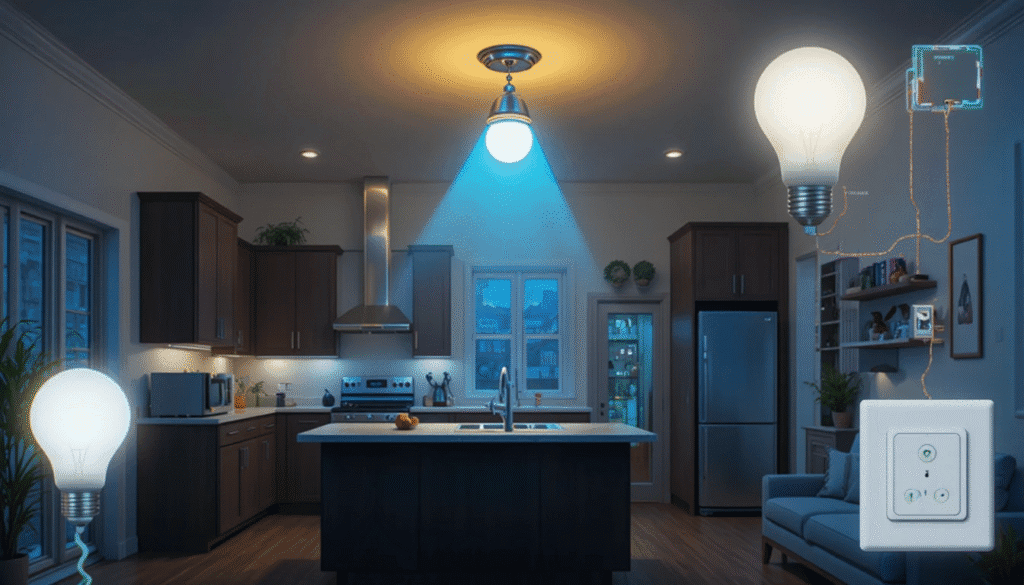Introduction
LED lights periodic flickering is one of the most common frustrations homeowners face today. Even though LED bulbs are designed to be energy-efficient, long-lasting, and reliable, occasional flickering can signal underlying electrical or compatibility issues. Whether your LED bulbs flicker when appliances turn on or flash intermittently, this guide covers the most frequent causes, solutions, and preventative measures.
By the end of this article, you’ll understand why LED lights flicker periodically, how to fix them safely, and how to prevent future occurrences while ensuring energy efficiency, bulb lifespan, and electrical safety.
Common Causes of LED Lights Periodic Flickering
Understanding why flicker occurs is the first step to resolving it. The primary causes include:
Voltage Fluctuations
When high-powered appliances like refrigerators, microwaves, or heaters operate, they can cause temporary voltage drops. These fluctuations can make LED lights flicker periodically and affect the bulb’s performance.
Low-Quality LED Drivers
Cheap LED bulbs often contain substandard drivers that cannot handle minor voltage variations. This leads to random flickering and reduces the bulb’s lifespan.
Loose Wiring or Faulty Connections
Loose connections in switches, sockets, or junction boxes are a common cause of LED light flashing problems. This is also a critical electrical safety hazard, as it can lead to short circuits or fire risks.
Dimmer Compatibility Issues
Older dimmers designed for incandescent bulbs may not work with LEDs. Using incompatible dimmers is a major reason for LED lights periodic flickering, especially when adjusting brightness levels.
High-Power Appliance Load
In homes where multiple devices share a single circuit, turning on heavy appliances can overload the circuit, causing flicker.
Aging or Overheating LEDs
Over time, LED drivers degrade, particularly in hot environments. Aging LEDs may flicker before completely failing.
Regional Differences and Residential vs Commercial Causes
Residential Homes
- Flickering is usually caused by dimmer incompatibility, bulb quality, or shared circuits.
Commercial Buildings
- Large appliances, machinery, and fluctuating loads can cause intermittent flicker.
Regional Observations
- United States: Flickering often results from low-quality bulbs or outdated dimmers.
- Canada: Voltage fluctuations during winter may trigger flicker.
- United Kingdom: 230V mains voltage amplifies flicker if wiring is loose.
- Australia: Peak electricity demand can cause temporary drops, affecting LEDs.
Case Study: Kitchen Circuit Overload
A homeowner’s kitchen LEDs flickered whenever the microwave ran. An electrician found the kitchen and living room shared a circuit. Redistributing the load eliminated the flicker completely.
Case Study: Bedroom Heater Issue
LED lights in the bedroom flickered whenever the electric heater turned on. After balancing the circuit and checking wiring connections, the flickering stopped.
Step-by-Step Fix for LED Lights Periodic Flickering
Step 1 – Observe Flicker Patterns
Identify when flicker occurs: randomly, when appliances start, or during dimming. Tracking patterns helps pinpoint the cause.
Step 2 – Inspect Wiring and Connections
Turn off power and inspect sockets, switches, and junction boxes. Tighten loose wires or replace damaged connections. Hiring a licensed electrician is recommended for safety.
Step 3 – Replace Low-Quality LED Bulbs
Use certified, high-quality bulbs from brands like Philips, Cree, or GE. Quality bulbs have robust drivers that resist LED driver flicker.
Step 4 – Use LED-Compatible Dimmers or Smart Switches
Replace incompatible dimmers with LED-compatible dimmers or smart switches. This ensures smooth dimming and eliminates flicker caused by driver incompatibility.
Step 5 – Install Surge Protectors and Stabilizers
Voltage spikes and drops can damage LED drivers. Surge protectors and stabilizers reduce LED lights periodic flickering and prolong bulb lifespan.
Step 6 – Call an Electrician for Persistent Issues
If flicker persists after replacing bulbs and switches, it may indicate faulty wiring, overloaded circuits, or a problematic breaker. Professional assessment is crucial.
Smart Dimmer LED Flicker Fix
Smart home setups may experience flicker due to bulb and switch incompatibility.
- Use bulbs approved by your dimmer or smart system.
- Ensure motion sensors or timers supply sufficient current.
- Premium smart bulbs like Philips Hue or LIFX have advanced drivers that prevent flicker.
💡 Tip: Keep bulbs and dimmers within the same ecosystem to reduce compatibility issues.
Cost of Fixing Flickering LED Lights
| Fix Type | Estimated Cost | Notes |
|---|---|---|
| DIY bulb replacement | $5 – $30 | Simple and safe for basic issues |
| LED-compatible dimmer/smart switch | $50 – $150 | Brand-dependent |
| Electrician for wiring issues | $100 – $300 | For loose connections or overloaded circuits |
| Full circuit rewiring | $1,000+ | Only for older homes or major electrical problems |
Preventing LED Lights Periodic Flickering in Your Home
- Use certified, high-quality LED bulbs.
- Ensure wiring meets local electrical codes.
- Install surge protectors or voltage stabilizers.
- Pair LEDs with compatible dimmers or smart switches.
- Schedule periodic electrical inspections to maintain circuit protection and load balancing.
Quick Comparison Table
| Cause | Typical Sign | Quick Fix |
|---|---|---|
| Voltage fluctuation | Flicker when appliances start | Surge protector / stabilizer |
| Poor LED driver | Random flicker | Replace bulb |
| Dimmer incompatibility | Flicker during dimming | Use LED-compatible dimmer |
| Loose wiring | Irregular flicker | Inspect and tighten connections |
FAQs
1. Why do LED lights flicker every few seconds?
Voltage fluctuations, low-quality drivers, or loose wiring are common causes.
2. Can bad wiring cause LED lights to flicker?
Yes. Loose or damaged wiring is a safety hazard and should be repaired immediately.
3. Do smart dimmers cause flicker?
Only if bulbs are incompatible with the dimmer.
4. How do I know if the flicker is from the bulb or wiring?
Replace the bulb first. Persistent flicker indicates wiring or switch issues.
5. Are flickering LED lights dangerous?
They can reduce lifespan, strain eyes, and indicate unsafe wiring.
6. Can voltage fluctuations damage LEDs?
Frequent drops or surges can harm LED drivers and shorten bulb life.
Conclusion
LED lights periodic flickering is common but manageable. Causes include voltage fluctuations, low-quality drivers, dimmer incompatibility, loose wiring, and overloaded circuits. Fixing these issues ensures electrical safety, extends bulb lifespan, and improves energy efficiency.
Always choose certified bulbs, inspect wiring, and follow local electrical codes. Implementing these practices prevents flicker and maintains stable, safe, and long-lasting LED lighting throughout your home.


